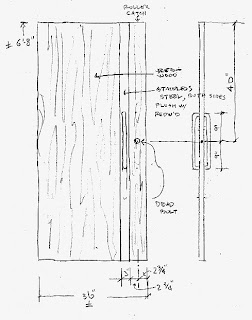How do you make a modern contemporary door using salvaged, recycled, and green materials ?
That was the question that I had to ask myself with a challenge of solving that situation while creating beautiful door.
"the rest of the story!"
I was asked by a local contractor, known as Rosenthal ~ Thorton Construction, if I could make a door similar to a sketch provided by their designer, Ron Press.
My first response was ......... SURE ......... then the caution sign started flashing and the sirens started getting louder. Why you ask ? Back in the 1400’s most of the doors were plank style doors made of boards attached together to fill the hole in the wall. Cut lumber, even though it is no longer growing, still swells and shrinks due to seasonal and climatic changes. This can mean that several boards fastened together would swell up in the rainy season and actually bind so tight that the plank door would swell to the point of not opening without a stiff shoulder and a running start. So that is the primary reason for developing a frame-and-panel door that really has only the outside boards that will swell and shrink.
So there must be a solution .......... and there is.
Take a 100% recycled waterproof substrate (core), edge it with Redwood (2”), on all four sides, and face it with book-matched thick veneers that give the plank appearance, but won’t swell and shrink during seasonal changes.
Now before you think of the postcard thin mass-produced veneers, as seen on most doors and furniture these days, think of slices of wood about 5/16” thick. We sawed these planks from vertical grain Old Growth Redwood lumber

Then we take these thick veneers and make two large sheets and adhere these beautiful pieces of wood to the inner core made of recycled material. This material will have to remain a “secret” for now, but it’s pretty cool! These faces we adhered with my ever faithful waterproof glue in a vacuum press. This press is like a giant “seal-a-meal” that exerts 1750 lbs of pressure on every square inch of surface. And I keep these pieces in my press for at least 72 hrs (3 days), until it is fully cured.
Next, after sanding, came the the inlay of a 3” wide stainless steel strip, on each side. This was “sorta” tricky, but we got it done and each piece wraps both ends and is affixed with stainless steel screws.
By the way, 90% of the consumer market stainless steel come from recycled sources.
“According to the International Stainless Steel Forum; unlike other recyclable materials, 85% - 95% of stainless steel does wind up being recycled - very little winds up in landfill. The is because stainless steel is so precious and durable.” (Sourcing http://www.greenlivingtips.com).
Last but not least, we found stainless D handles that we mounted on both sides. They wanted handles that mounted without visible mounting brackets and we found this hardware through a wonderful online company called KnobDeco (http://www.knobdeco.com). I think you’ll agree these handles are like candles on the cake!
If you are interested in viewing more of this door, please visit our Door Gallery and check out The Sea Cliff Entry.
I also would like to invite any questions you may have regarding custom doors, gates, or stained glass.
I also would like to invite any questions you may have regarding custom doors, gates, or stained glass.






